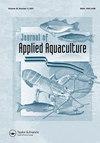Seed production of Pearlspot (Etroplus suratensis) in natural ponds
IF 0.8
Q3 FISHERIES
引用次数: 0
Abstract
ABSTRACT Pearlspot (Etroplus suratensis) is an indigenous fish endemic to India and Sri Lanka. It is the state fish of Kerala and very popular in the main tourist destinations/cousins in Kerala. It is mainly collected from brackish water creeks and canals for domestic consumption. However, several environmental and ecological problems lead to the significant reduction of pearlspot in natural water bodies. The promotion of Pearlspot farming is the only sustainable solution for this crisis. Nevertheless, one of the main issues in Pearlspot farming is the lack of quality seeds in sufficient quantities to undertake commercial farming. Massive seed production is the only way to meet the ever-increasing demand for Pearlspot seed. Several attempts to produce Pearlspot seed stock under hatchery conditions have been unsuccessful. The present paper reports the methods to achieve the mass-scale seed production using pond based seed production method. In this, two brackishwater ponds, each with dimensions of 40 m × 50 m × 0.9 m and water access from the creek, were selected. Scientific procedures were followed to produce large Pearlspot seeds throughout the year. The technology ensures the production of 50,000 seeds from a single breeding pond of 0.5-acre area, which can meet the seed requirement for above 3 ha area. The present study proved that Pearlspot reproduction in natural ponds could produce seed stock on a commercial scale.天然池塘中珍珠斑(Etroplus suratensis)的种子生产
摘要 珍珠斑(Etroplus suratensis)是印度和斯里兰卡特有的土著鱼类。它是喀拉拉邦的国鱼,在喀拉拉邦的主要旅游景点/表亲中非常受欢迎。它主要从咸水溪流和运河中采集,供家庭食用。然而,一些环境和生态问题导致天然水体中的珍珠斑显著减少。推广珍珠斑养殖是解决这一危机的唯一可持续办法。然而,珍珠斑养殖的主要问题之一是缺乏足够数量的优质种子来进行商业养殖。大量生产种子是满足对珍珠斑种子日益增长的需求的唯一途径。在孵化条件下生产珠斑种群的多次尝试均未成功。本文报告了利用池塘制种法实现大规模制种的方法。在此过程中,选择了两个咸水池塘,每个池塘的尺寸为 40 m × 50 m × 0.9 m,水源来自小溪。按照科学程序,全年生产大量珍珠斑种子。该技术可确保单个 0.5 英亩面积的育种池生产 50 000 粒种子,满足 3 公顷以上面积的种子需求。本研究证明,在天然池塘中繁殖珍珠斑可以生产出商业规模的种群。
本文章由计算机程序翻译,如有差异,请以英文原文为准。
求助全文
约1分钟内获得全文
求助全文
来源期刊

Journal of Applied Aquaculture
Environmental Science-Ecology
CiteScore
3.20
自引率
0.00%
发文量
38
期刊介绍:
The Journal of Applied Aquaculture is a platform for the sharing of practical information needed by researchers to meet the needs of investors, farm managers, extension agents and policy makers working to adapt aquaculture theory to achieve economic and food security objectives in the real world. The journal emphasizes multi-disciplinary research and case studies that propose financially and logistically viable solutions to observable problems.
 求助内容:
求助内容: 应助结果提醒方式:
应助结果提醒方式:


